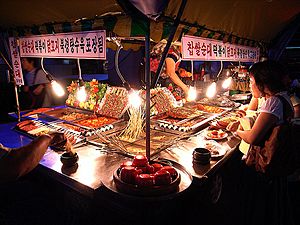Pojangmacha facts for kids
| Pojangmacha | |

Pojangmacha food stall
|
|
Quick facts for kids Korean name |
|
|---|---|
| Hangul |
포장마차
|
| Hanja |
布帳馬車
|
| Revised Romanization | pojangmacha |
| McCune–Reischauer | p'ochangmach'a |
Pojangmacha (포장마차) are popular street food spots in South Korea. They are usually small tents, sometimes on wheels, or simple street stalls. The name Pojangmacha means "covered wagon" in Korean. These places are famous for selling delicious and quick street foods.
Contents
What are Pojangmacha?
Pojangmacha are a unique part of Korean culture. They offer a fun and casual way to enjoy a meal. You can often find them busy late into the night. Many people grab a snack or a quick bite to eat while standing. Some Pojangmacha even have simple chairs or benches for you to sit down.
Delicious Street Foods to Try
Pojangmacha sell many kinds of popular Korean street foods. Here are some you might find:
- Hotteok: A sweet pancake, often filled with brown sugar syrup.
- Gimbap: Rice rolls wrapped in seaweed, similar to sushi.
- Tteokbokki: Spicy rice cakes, a very popular snack.
- Sundae: A type of Korean sausage.
- Dakkochi: Skewered chicken, grilled and often seasoned.
- Odeng: Fish cakes served on skewers in a warm broth.
- Mandu: Korean dumplings, steamed or fried.
Pojangmacha Through the Years
Pojangmacha might seem new, but they continue a long Korean tradition. For hundreds of years, Korean sellers would move around to find their customers. They didn't make customers come to them. Pojangmacha are just the newest way this tradition continues. They offer fast food and drinks close to where people work and live.
How Pojangmacha Started
The first Pojangmacha appeared in the early 1950s in Seoul. Back then, they were small cars or carts. They sold simple snacks and drinks out in the open. Later, some smart sellers started covering their carts with orange tarps. They also added stools for people to sit on. This idea became very popular. Soon, a typical Pojangmacha had a tent covering a small cart and a few stools.
Growing in Popularity
In the 1970s, Pojangmacha became even more popular in Seoul. This was partly because of Korea's "Palli-palli" (빨리-빨리) culture, which means "hurry up." Many Koreans worked late hours. As they left work, they would stop at a Pojangmacha for a quick meal. Over time, Pojangmacha grew bigger and added more comfortable tables. Their menus also became much more varied.
Pojangmacha Today
Today, you can find many Pojangmacha in the back streets of cities like Seoul, Daegu, Daejeon, and Busan. However, their numbers have changed. Around 2012, there were about 3,100 in Seoul. City officials have tried to reduce them. They sometimes thought the stalls looked messy or were not always clean.
Some places now call themselves "indoor Pojangmacha" (실내포장마차). These are not actual tents or carts. They are usually bars or restaurants that use the name to suggest a casual and affordable atmosphere, similar to the original street stalls.
See also
 In Spanish: Pojangmacha para niños
In Spanish: Pojangmacha para niños


